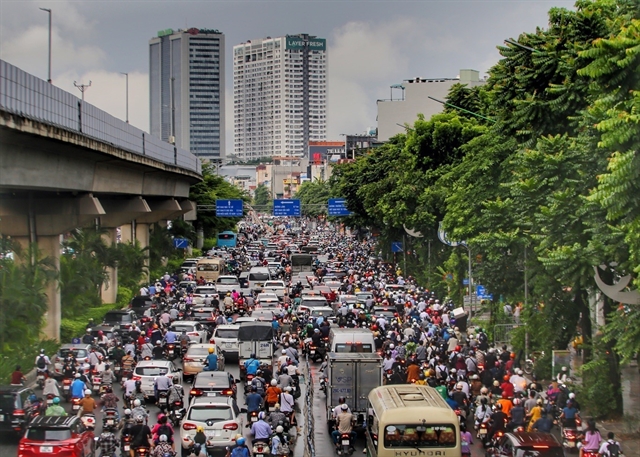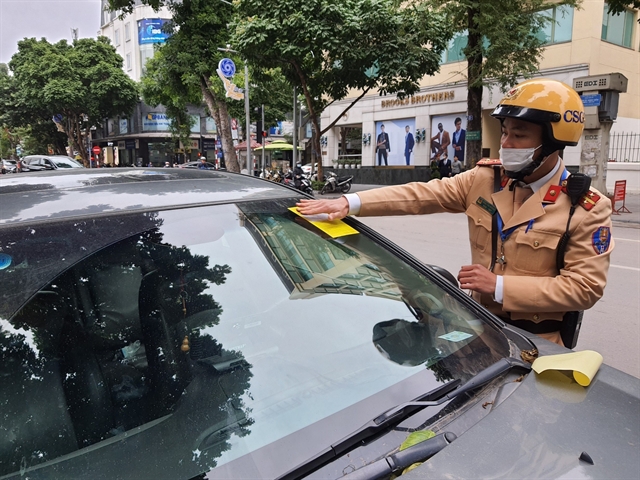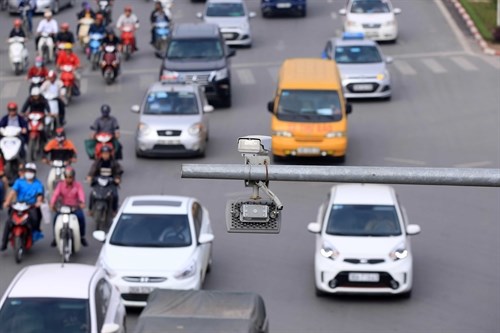 Society
Society

 |
| Traffic congestion on Nguyễn Trãi Street in Hà Nội after heavy rain on August 1, 2023. VNA/VNS Photo Tuấn Đức |
By Khánh Linh
HÀ NỘI – Hà Nội urgently needs to transition into a smart city, with the development of an intelligent transportation system (ITS) one of the key pillars to tackle existing challenges.
These difficulties include congestion, traffic accidents, environmental pollution, and building a safe, connected, and sustainable urban transportation system, transport experts have said.
According to Nguyễn Phi Thường, Director of the Hà Nội’s Department of Transport, the transportation system is considered the lifeblood of the economy and the face of the city. Developing an intelligent and sustainable transportation system is a global trend for all cities, including Hà Nội.
Despite recent efforts to modernise the capital's transportation in recent years, the current quality of the transport system does not meet the actual needs.
Figures from the department show that currently, Hà Nội has nearly eight million vehicles, including over one million cars, 6.6 million motorcycles, and nearly 185,000 electric motorcycles.
The city’s population is growing by 200,000 people each year, leading to a ten per cent increase in cars, three per cent in motorcycles, and an overall four per cent growth in vehicles.
However, the allocated land for transportation is limited, accounting for approximately 10.35 per cent of the total construction area. Transportation infrastructure only increases by 0.5 per cent per year, while the number of vehicles increases by 4-5 per cent, leading to persistent traffic congestion.
"The city is very concerned about allocating resources to improve infrastructure, but the development speed of infrastructure has not kept up with the rapid growth of vehicles," Thường said.
Resolution No. 10-NQ/TU issued on December 30, 2022, by the Hà Nội Party Committee sets the goal of building Hà Nội into a smart and modern city with a connected urban traffic network by 2030, with ITS playing an important role in the city’s development.
Hà Nội has already implemented AI solutions in traffic control and piloted smart traffic models, incorporating applications for smart traffic applications for bus searches, surveillance cameras, bus e-tickets, and parking searches. However, these initiatives lack coherence and connectivity.
To address this, the city’s Department of Transport has selected the University of Transport and Communications as the consulting unit to develop ITS for the city until 2023 with a vision toward 2045.
The project aims to provide a framework for the ITS architecture, as well as offer strategies and solutions related to policies, technology, and investment. The project also serves as a basis for managing and investing in smart transportation projects in the future.
As of now, the project has achieved significant progress and is currently in the process of gathering feedback and opinions.
 |
| On-duty traffic police officers handling traffic violations through the surveillance camera system at the Hà Nội Traffic Control Centre. VNA/VNS Photo Doãn Tấn |
Dr Lê Hùng Lân, head of the ITS research project in Hà Nội pointed out that most projects, mainly implemented through applications, prioritise pressing issues such as the installation of surveillance camera systems for traffic law compliance, controlled traffic signal lights, the establishment of minimal-scale traffic control centres, and the deployment of software applications for services like parking assistance, route finding, and bus identification.
The key focus should be on developing an appropriate roadmap to achieve the goal of enhancing the quality of people's mobility and efficiently managing urban traffic.
According to statistics from the project development team, traffic congestion is widespread during peak hours in the city. In 2022, there were a total of 35 congestion hotspots during peak hours, with eight being addressed. In 2023, there are a total of 37 congestion hotspots, and as of now, nine have been resolved.
The damage caused by traffic congestion to Hà Nội ranges from US$1-1.2 billion annually.
Additionally, the air pollution index is more than five times the regulated limit, and the concentration of PM2.5 dust is approximately three times higher, adversely affecting people’s health.
Traffic congestion also causes losses of over one million work hours per year, as highlighted in the report.
Lân explained that ITS would consist of four main components, including ITS users, smart device-integrated vehicles, smart transportation infrastructure, and the city's traffic control and monitoring centre.
Among these, ITS users primarily include the citizens participating in traffic and those managing and operating traffic. Users not only receive ITS services but also actively contribute information to ITS.
"The ITS in Hà Nội is not a product. It is a new method of traffic management and control. Developing an ITS is a long-term and continuous process that requires determination and effort to build an innovative smart transportation ecosystem."
However, Lân said, the challenges for building ITS in the city are the insufficient land allocation for transportation, accounting for less than half of the required amount, underdeveloped public transport mainly relying on buses, meeting less than 20 per cent of demand, and lack of developed green transportation methods such as walking and cycling.
Additionally, there is a lack of connectivity and information sharing in management and operation. There are few smart transportation applications, the absence of a smart traffic control centre, and incomplete technical standards for investing in smart transportation equipment.
 |
| A traffic police officer issuing a parking ticket for a car illegally parking at Bà Triệu Street in Hà Nội. VNA/VNS Photo Doãn Tấn |
Therefore, Lân suggested that the roadmap for ITS in Hà Nội should be divided into three stages.
In Stage 1, from 2024 to 2026, the city will focus on establishing its traffic control and operation centre, investing in installing ITS peripheral devices, connecting data sources, and implementing integrated ticketing.
Stage 2, spanning from 2027 to 2030, involves implementing the inner-city toll collection. Additionally, it includes the construction of an integrated smart traffic control centre, the development of basic ITS applications, and investment in installing ITS peripheral devices.
In Stage 3, extending until 2045, it continues implementing the inner-city toll collection while persisting in efficiently operating the city's ITS, completing the ITS infrastructure, and enhancing applications that leverage traffic data.
The project has gained commitment from the World Bank to accelerate the conversion to electric buses and the implementation of ITS in Hà Nội for the city's sustainable development.
"The ITS in Hà Nội is not a product. It is a new method of traffic management and control. Developing an ITS is a long-term and continuous process that requires determination and effort to build an innovative smart transportation ecosystem," he stressed.
Project feasibility
Providing feedback on the project, Michael Chiu, a senior transport consultant from the World Bank, believed that Stage 1 would be the most crucial for the project.
After getting approval, it would be necessary to thoroughly study feasibility, establish technical standards, prepare tender documents, and execute construction.
"Therefore, it is necessary to extend Stage 1 to four or five years to establish a detailed programme," he said.
The World Bank representative also stressed the importance of expanding the pilot implementation of handling traffic violations through image data (CCTV) to address shortcomings in human enforcement and create more favourable conditions for evidence gathering.
Currently, the city has installed 579 surveillance cameras at 149 traffic junctions, including 117 for traffic observation, 195 for issuing penalties for traffic violations, and 267 for vehicle detection.
Moreover, he suggested the construction of a priority system for public transportation, including separate lanes for buses to improve accessibility for passengers, the establishment of an air quality monitoring system similar to that in Beijing, China, and enhancing the capabilities of personnel operating this model.
 |
| A camera is installed at a traffic junction in Hà Nội for issuing penalties for traffic violations. VNA/VNS Photo |
Based on the experiences of implementing ITS in Wuhan City in China, Yang Chen, a senior official from the World Bank, emphasised that the limitations of investing in ITS lay in constrained financial resources and technical challenges.
She also provided three recommendations. Building a sustainable smart transportation system was an ongoing development process that would require significant resources from both the government and society. Therefore, it was crucial to engage all stakeholders, both public and private, in a collaborative and transparent environment.
Developing the technical capabilities to procure and monitor information services would be essential, along with a focus on fundamental infrastructure, including a well-connected road network and basic traffic management measures such as traffic signals, she said.
Evaluating the project, Dr Trần Thiện Chính from the Post and Telecommunications Institute of Technology suggested that the project should thoroughly analyse the strengths and weaknesses of the current transportation system, and propose plans based on that.
Chính said the project was mainly focused on hardware systems, software platforms, and utilities without addressing the construction of transportation infrastructure systems.
He also noted that the project outlined a roadmap in three stages, so policy mechanisms and impact assessments should be specifically tied to each stage.
Dr Nguyễn Thanh Hải, Head of the Electrical-Electronics Department at the University of Transport and Communications, agreed, saying that the content in each stage needed to clarify the upgrades and improvements compared to the existing system.
He took the traffic management and control centre as an example. It was necessary to specify which would need to be changed and the feasibility of intervening in the current operating system, he added. – VNS




